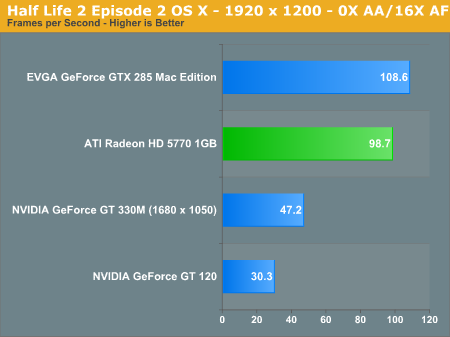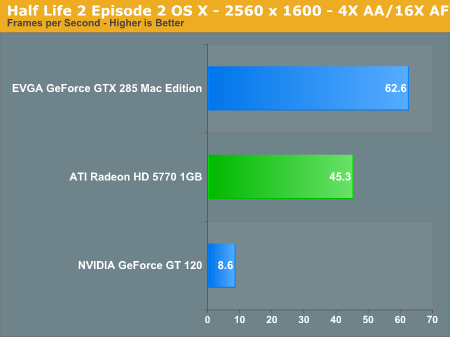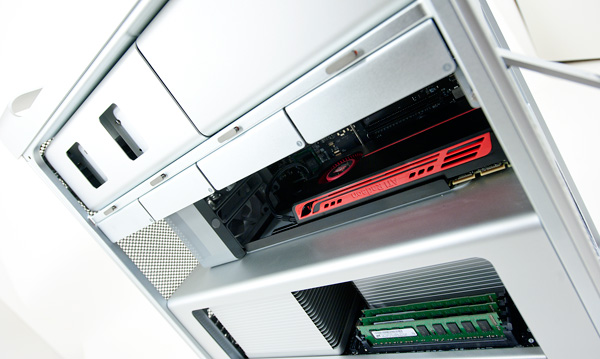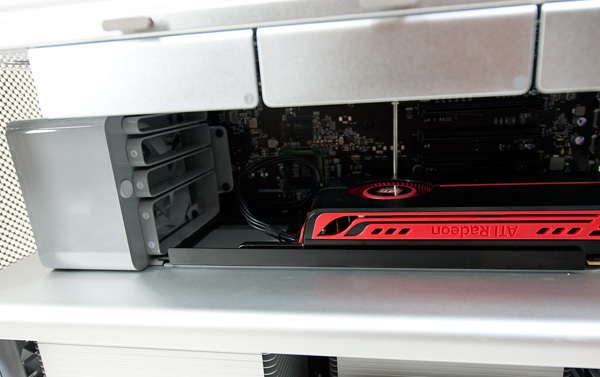Apple Mac Pro (Mid 2010) Review
by Anand Lal Shimpi on October 6, 2010 9:26 PM ESTNew GPUs
In one fell swoop Apple pulled NVIDIA out of almost all of its desktop products. With the exception of the Mac mini, every single Apple desktop uses an Intel CPU, an Intel chipset and an AMD GPU. To be fair though, Apple has alternated between NVIDIA and AMD for graphics every year for the past four years.
The GPU of choice in the Mac Pro is the Radeon HD 5770 equipped with 1GB of GDDR5. Clocked and spec'd identically to the PC version, this is the graphics card you get in all three standard models. For an extra $200 you can get a Radeon HD 5870 with 1GB of GDDR5, and for an extra $250 you can have two 5770s instead of one. Don't get too excited, the multi-GPU route is explicitly for more displays there's no concept of CrossFire under OS X at this point.
The Radeon HD 5770 is a huge step up from the GeForce GT 120 that previously came standard in the Mac Pro. The performance difference between the two is staggering! Where the 5770 does disappoint however is in comparison to EVGA's GeForce GTX 285 Mac Edition. It's slower.
I used Half Life 2 Episode 2 under OS X to get a general idea of gaming GPU performance. The improvement is huge compared to the old GeForce GT 120 that shipped in last year’s Mac Pro. Ultra high resolution frame rates improved by over 5x, while even 19x12 performance tripled.



If you’re curious about Starcraft 2 performance of the Radeon HD 5770 at 2560 x 1600, ultra quality settings, I saw an average frame rate of ~21 fps with a minimum at 17 fps and maximum at 27 fps. Note that this is in our CPU intensive battle test, so peak frame rates will be higher but if you’re doing a lot of unit management that’s pretty much what you can expect. In other words it’s not fast enough to play on a 30” at full resolution without feeling a bit choppy at times. To average above 30 fps you have to drop resolution and quality settings.
Display Outputs and Frame Buffer
The 5770 has three outputs in the form of two mini-DP and one dual-link DVI. The mini-DP ports can each drive a 27-inch LED Cinema Display while the DL-DVI port can drive a 30. This is a Radeon HD 5000 series card so you can actually have all three outputs active at the same time. That's right, with a single card you can drive three monitors. And with two, six monitors.
While 1GB of memory is enough to drive a single high resolution panel, it can be a stretch for two or three depending on what you're doing. As I've pointed out in the past you can have around 130 open Safari windows before you'll max out a video card with a 1GB frame buffer at 2560 x 1600. However, fire up Photoshop and open twenty 12MP images and you'll get the same effect. For heavy imaging work you'll still want more than one 5770 if you are going to drive multiple high resolution (2560 pixels wide) displays.
What would've been better is for Apple to offer a 2GB card, at least as an option, for very high end multi-monitor users.












84 Comments
View All Comments
jasperjones - Thursday, October 7, 2010 - link
OS X hasn't supported NUMA for the longest time. imo it's of some importance on a dual-socket system with 8 or 12 cores. So, question: has Apple finally got around to make it work with the Mac Pro '10? If not, I assume that similarly-configured Dell and HP systems which run Linux or Windows will perform better in some scenarios.metaungulate - Thursday, October 7, 2010 - link
The KVR1333D3K3/3GR is Unbuffered. This won't work.Ben90 - Thursday, October 7, 2010 - link
Xeons support ECC not require it.Stuka87 - Thursday, October 7, 2010 - link
Buffered and ECC are different, and should not be confused with each other. Older Xeon's did use FBDIMM's, but current Xeons use standard DDR in either Non-ECC, ECC, or Buffered ECC unless the chipset used specifically calls for one or the other.metaungulate - Thursday, October 7, 2010 - link
Thank you for the clarification. However, these are the current prices on newegg.com:Intel Xeon E5620 Westmere 2.4GHz 12MB L3 Cache LGA 1366 80W Quad-Core Server Processor BX80614E5620: $384.99 x 2
Kingston ValueRAM 3GB (3 x 1GB) 240-Pin DDR3 SDRAM DDR3 1333 (PC3 10666) Triple Channel Kit Desktop Memory Model KVR1333D3K3/3GR: $60.99 x 2
SAPPHIRE 100283-3L Radeon HD 5770 1GB 128-bit GDDR5 PCI Express 2.0 x16 HDCP Ready CrossFireX Support Video Card: $139.99
Western Digital Caviar Black WD1001FALS 1TB 7200 RPM 32MB Cache SATA 3.0Gb/s 3.5" Internal Hard Drive -Bare Drive: $79.99
LG Black 24X DVD+R 8X DVD+RW 16X DVD+R DL 24X DVD-R 6X DVD-RW 12X DVD-RAM 16X DVD-ROM 48X CD-R 32X CD-RW 48X CD-ROM SATA DVD Burner - Bulk LightScribe Support - OEM: $20.99
Corsair Obsidian Series 700D CC700D Black Aluminum / Steel ATX Full Tower Computer Case: $249.99
Antec TruePower New TP-750 750W Continuous Power ATX12V V2.3 / EPS12V V2.91 SLI Certified CrossFire Ready 80 PLUS BRONZE Certified Active PFC: $109.99
ASUS Z8NA-D6C Dual LGA 1366 Intel 5500 ATX Dual Intel Xeon 5500 and 5600 Series Server/Workstation Motherboard: $259.99
On what planet is this: $1612.91?
The actual cost is: $1,752.90.
Anand Lal Shimpi - Thursday, October 7, 2010 - link
That's the issue with non-realtime pricing, it changes. I've updated to the latest numbers :)kevin2i - Sunday, October 31, 2010 - link
The article is still wrong -- pricing does not include an OS.1752 Parts
199 Windows 7 Professional
Didn't see wifi/bluetooth, firewire, mouse, keyboard either.
iLife suite? - The user may or may not find it useful. Although I have Final Cut, I typically use iMovie for simple tasks.
Home box: No real warranty, no resale value -
The apple tax is looking more like a refund compared to a home built system.
zorxd - Thursday, October 7, 2010 - link
The Apple tax is clearly there. Only, there is also a Dell tax this time.Also, the Apple tax would look even worse if you compared the single socket system, since you could get a Core i7 (or maybe even i5) instead of the Xeon for the same (or better) performance with a much cheaper motherboard and CPU.
metaungulate - Thursday, October 7, 2010 - link
Yeah, don't get me wrong, I still think that the build is the way to go at $1752.90. Just pointing out that if Anandtech wants to be such a trusted technical resource it would help if the writers knew how to use a calculator. :)Nadav2010MP - Friday, October 8, 2010 - link
But, for those like me who have a 2009 mac pro, all I had to do was spend 300 dollars for the two main parts to make my 09 a 2010.. The backplane board 661-5706 was only 250.00 from an on-line site.. and the processor board only cost me 46.00 - so, for 300.00, using the w3580, my 8GB 1066 mhz memory and 5770 - I was able to remove the original 09 parts and replace them with 2010 parts.. The heatsink from the 09 is the EXACTLY same as the 2010... rather the other way.. the 2010 uses the same 09 parts, some are marked with different part numbers to distinguish them, but for the most part.. all fans, case components work on the 2010 backplane board, as this board is the same exact board as in the 09 except Apple flashed it with the firmware to support westmere and 1333 mhz memory.Dual is a totally different story... it wouldn't be cost effective to move from a single to a dual because you lack the heatsinks(those two alone would be near 400 dollars), while the dual processor board would only be 76 dollars(macpartsonline.com), you still need the dual processors and THOSE ALONE would cost more than the machine or come close to the cost of a new 2010 already.
The upgrade from 09 single to 2010 single can be done for 300.00 and thats it.. you are done. But the dual would cost far more.